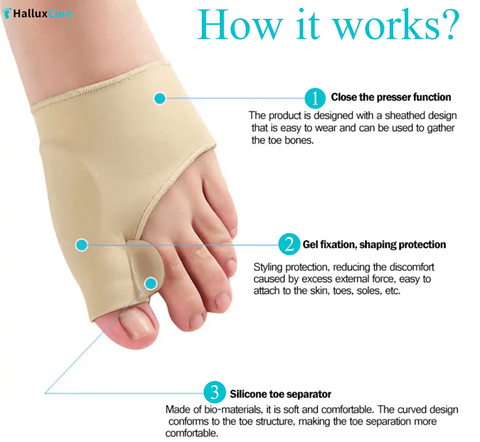Choosing the Right Path: Bunion Surgery vs. Non-Surgical Relief Options
Last Updated: December 7th 2024
Author: Dr. Emily Harper, DPM – Board-Certified Podiatrist
Bunions are more than just a cosmetic issue—they can lead to significant discomfort, reduced mobility, and a lower quality of life. For some, bunion surgery may seem like the ultimate solution, while others find relief through non-surgical treatments. This article breaks down the pros and cons of both approaches, leveraging expert insights, patient experiences, and evidence-based recommendations.
Key Takeaways
- Surgery is often best for severe bunions causing daily pain or structural damage but comes with recovery time and risks.
- Non-surgical options like orthopedic sleeves, footwear adjustments, and physical therapy can effectively manage mild to moderate bunion symptoms.
- Consult a podiatrist to determine the right approach tailored to your condition and lifestyle.
Understanding Bunion Surgery: Insights from a Patient's Perspective
Bunion surgery is often considered when conservative methods fail to provide relief. In one Reddit user's account, they shared their experience with foot surgery for a related condition, MTP joint fusion. While their case differs slightly from bunionectomy procedures, their story sheds light on potential outcomes.
Expert Commentary on Bunion Surgery
Dr. Emily Harper explains:
"Bunion surgery, such as a Lapidus bunionectomy, is highly effective for severe cases, but it’s not without trade-offs. Patients should expect a recovery period of 6–12 weeks and potential long-term stiffness in the toe joint. It’s crucial to weigh these factors against the benefits of pain relief and improved mobility."
Pros of Surgery:
- Pain Relief: Chronic pain is often alleviated, enabling patients to resume everyday activities.
- Corrected Deformity: Surgery can restore the natural alignment of the foot.
- Improved Mobility: Post-surgery, patients typically report being able to walk longer distances with reduced discomfort.
Cons of Surgery:
- Stiffness: Limited flexibility in the joint is a common side effect.
- Extended Recovery Time: Healing can take several months, impacting work and daily routines.
- Balance Concerns: Addressing one foot may lead to asymmetry if the other foot remains untreated.
Is Surgery Always the Best Option for Bunions?
Not all bunions require surgical intervention. In fact, conservative treatments are often effective for managing mild to moderate symptoms. Surgery should only be considered when the bunion causes severe pain, interferes with daily activities, or leads to progressive deformity.
Signs You May Need Surgery:
- Severe, Chronic Pain: Pain that persists despite using non-surgical options.
- Progressive Worsening: A bunion that continues to grow and deform the foot.
- Arthritis or Joint Damage: Structural complications that cannot be managed conservatively.
Non-Surgical Alternatives:
For many individuals, non-invasive options can help relieve pain, slow bunion progression, and improve overall foot health.
1. Orthopedic Bunion Pain Relief & Correction Sleeves
Designed for mild to moderate bunions, these sleeves help realign the toe and reduce pressure.
4.9 ⭐⭐⭐⭐⭐ ( 1843 reviews )
2. Supportive Footwear
- Look for shoes with a wide toe box to reduce pressure on the bunion.
- Avoid high heels, which can exacerbate alignment issues.
3. Physical Therapy
- Stretching and strengthening exercises can improve flexibility and reduce discomfort.
- Toe stretches and resistance exercises are particularly effective.
4. Pain Relief Products
Topical treatments like the Jamaica Black Castor Oil Soothing Oil provide anti-inflammatory benefits while moisturizing the skin.
Practical Tips for Managing Bunions Without Surgery
- Incorporate Foot Exercises: Stretch and strengthen the muscles around the bunion daily.
- Use Orthotics: Custom or over-the-counter insoles can redistribute pressure across your foot.
- Apply Ice Packs: Reduce swelling after long periods of standing or walking.
- Choose the Right Socks: Opt for seamless, cushioned socks to minimize irritation.
- Track Progress: Keep a journal of symptoms to assess whether treatments are helping.
FAQs
-
Can bunions go away without surgery?
No, bunions cannot be reversed without surgery. However, non-surgical treatments can alleviate symptoms and prevent further progression. -
What are the risks of bunion surgery?
Risks include infection, nerve damage, stiffness, and recurrence of the bunion. Always discuss potential complications with your surgeon. -
What is the recovery time for bunion surgery?
Recovery typically takes 6–12 weeks, but it may take longer for the foot to regain full strength and mobility. -
Are bunion sleeves effective?
Yes, bunion sleeves, like the Orthopedic Bunion Pain Relief & Correction Sleeve, are effective for relieving pressure and providing mild correction in the early stages. -
When should I see a podiatrist?
If bunions cause persistent pain, interfere with daily activities, or worsen over time, consult a podiatrist for a professional evaluation.
Disclaimers and Disclosures
This article is for informational purposes only and does not constitute medical advice. Always consult a qualified healthcare professional for diagnosis and treatment. Some links in this article are affiliate links, meaning we may earn a commission if you purchase through them. This does not affect the price you pay and helps support our work.
Conclusion
Deciding between bunion surgery and non-surgical treatments depends on the severity of your condition, your lifestyle, and your personal goals. While surgery offers a permanent fix for severe cases, non-surgical measures are often sufficient for managing discomfort and preventing progression.
If you're exploring non-invasive options, products like the Orthopedic Bunion Pain Relief & Correction Sleeve and Jamaica Black Castor Oil Soothing Oil can be excellent starting points.
Remember, the most important step is consulting with a trusted podiatrist to develop a treatment plan tailored to your needs.



